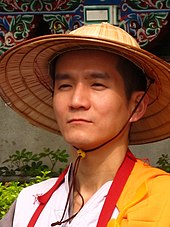Our website is made possible by displaying online advertisements to our visitors.
Please consider supporting us by disabling your ad blocker.
Buddhism in Taiwan

| Part of a series on |
| Buddhism |
|---|
 |
Buddhism is one of the major religions of Taiwan. Taiwanese people predominantly practice Mahayana Buddhism, Confucian principles, Taoist tradition and local practices.[1] Roles for religious specialists from both Buddhist and Taoist traditions exist on special occasions such as for childbirth and funerals. Of these, a smaller number identify more specifically with Chinese Buddhist teachings and institutions, without necessarily eschewing practices from other Asian traditions. Around 35% of the population believes in Buddhism.[2]
Taiwanese government statistics distinguish Buddhism from Taoism, giving almost equal numbers for both. In 2005, the census recorded 8 million Buddhists and 7.6 million Taoists, out of a total population of 23 million.[3] Many of Taiwan's self-declared "Taoists" actually observe the more syncretistic practices associated with Chinese traditional religion which is based on Buddhism. Self-avowed Buddhists may also be adherents of more localized faiths such as Yiguandao, which also emphasize Buddhist figures like Guanyin or Maitreya and espouse vegetarianism.
Distinguishing features of Taiwanese Buddhism is the emphasis on the practice of vegetarianism, the influence of Humanistic Buddhism, and the prominence of large centralized Buddhist organizations. Four Buddhist teachers who founded institutions that are particularly influential are popularly referred to as the "Four Heavenly Kings of Taiwanese Buddhism",[4] one for each cardinal direction, with their corresponding institutions referred to as the "Four Great Mountains". They are:
- North (Jinshan): Master Sheng-yen (聖嚴, 1931–2009) of Dharma Drum Mountain (法鼓山)
- South (Dashu): Master Hsing Yun (星雲, 1927–2023) of Fo Guang Shan (佛光山)
- East (Hualien): Master Cheng Yen (證嚴, 1937–) of the Tzu Chi Foundation (慈濟基金會)
- West (Nantou): Master Wei Chueh (惟覺, 1928–2016) of Chung Tai Shan (中台山)
Following the Chinese Civil War, Buddhism experienced a rapid increase in popularity in Taiwan, attributed to Taiwan's economic miracle following the war and several major Buddhist organizations promoting modern values such as equality, freedom and reason, which was attractive to the country's growing middle class.[5][6] Taiwanese Buddhist institutions are known for their involvement in secular society, including the providing of a number of public goods and services such as colleges, hospitals and disaster relief.[5]
- ^ "Major Religions Ranked by Size". adherents.com. Archived from the original on 22 April 2011. Retrieved 27 August 2009.
- ^ Benoit, Vermander S.J. (Winter 1998). "Religions in Taiwan: Between Mercantilism and Millenarianism" (PDF). Inter-Religio. Taipei Ricci Institute: 63–75. Archived (PDF) from the original on 3 April 2012. Retrieved 24 February 2012.
- ^ Sakya, Madhusudan (1 January 2011). Current Perspectives in Buddhism: Buddhism today : issues & global dimensions. Cyber Tech Publications. p. 95. Archived from the original on 16 January 2023. Retrieved 22 April 2017.
- ^ Abeynayake, Oliver; Tilakaratne, Asanga (1 January 2011). 2600 Years of Sambuddhatva: Global Journey of Awakening. Ministry of Buddhasasana and Religious Affairs, Government of Sri Lanka. p. 282. ISBN 978-955-9349-33-4. Archived from the original on 16 January 2023. Retrieved 10 April 2017.
- ^ a b Schak, David; Hsiao, Hsin-Huang Michael (1 June 2005). "Taiwan's Socially Engaged Buddhist Groups". China Perspectives. 2005 (59). doi:10.4000/chinaperspectives.2803. ISSN 1996-4617. Archived from the original on 12 October 2016. Retrieved 31 December 2016.
- ^ Democracy's Dharma: Religious Renaissance and Political Development in Taiwan by RichardMadsen Review by: Scott Pacey The China Journal, No. 60 , pp. 203–205 (University of Chicago press, July 2008) 203].
Previous Page Next Page


